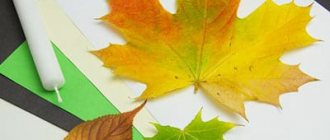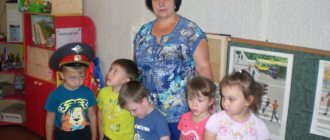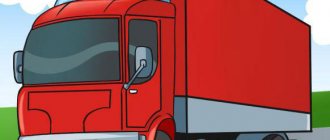GCD plan for preschoolers of the middle group. Topic: Transport
Plan-summary of educational activities for children of the middle group on the topic “Transport”
Author: Nikolaeva Elena Andreevna Place of work: teacher of MDOU Secondary School No. 1 SP-d\s “Fairy Tale” p. Sukhodol Sergievsky district Samara region
Plan-summary of direct educational activities with preschoolers middle group.
The lesson helps introduce children to modes of transport: land, water, air. Topic of the week: “Transport”. Integration of educational areas: “Social and communicative development”, “Cognitive development”, “Speech development”, “Artistic and aesthetic development”, “Physical development”. 1. Purpose. Introduction to modes of transport. 2. Objectives. “Cognitive development”: form the concept of “transport”; consolidate children's knowledge about types of transport - land, water, air; expand children's knowledge about land, water and air modes of transport: structural features of a car, plane, ship, place of transport - land, water, air; purpose of transport. Develop an interest in technology. “Social and communicative development”: Develop skills of polite treatment, friendliness, discipline. “Artistic and aesthetic development”: continue to work on developing the ability to listen carefully and consciously to a literary work (poem), develop auditory memory, improve visual skills and abilities, develop artistic and creative abilities, and introduce children to music. “Speech development”: develop the ability to construct complete answers, the ability to listen carefully. Stimulate the desire to participate in conversation, develop auditory attention. Continue work on developing the ability to convey the main idea of a work, develop the ability to use a generalizing word - “transport”; form an active vocabulary in accordance with the lexical topic “Transport”: cars, driver, driver, steering wheel, ship, boat, cutter, porthole, anchor, deck, stern, captain, plane, helicopter, rocket, wings, nose and tail of an airplane, engine , pilot. “Physical development”: develop motor activity. 3. Methods and techniques: - practical (didactic game, physical education lessons, surprise moment, outdoor game, creation of an artistic product - drawing, appliqué, construction); - visual (looking at illustrations, showing, listening to music); - verbal (conversation, explanation, reading poetry, asking riddles). 4. Materials and equipment: Hero - Carlson (toy); a sheet of paper, divided into two halves: “passenger” (schematic representation of men) and “cargo” (schematic representation of a load of sand); pictures of vehicles by number of children; glue stick, ? landscape sheet with a picture of transport made of dots, felt-tip pens; colored pencils, coloring books; blanks for application on the theme “Transport”; tables for children's creativity, easel, music "Riding a Train", N. Rimsky - Korsakov's work "Flight of the Bumblebee", illustrations depicting water, air and land transport, colored steering wheels, toy cars. 5. Forms of organizing joint activities 1. motor: outdoor game “Colored Cars”, game exercise, physical education sessions.
2. Game: story game, didactic game, finger game. 3. Productive: independent artistic creative activity, making drawings, applique, buildings from building materials. 4. Communicative: conversation, guessing riddles. 5. Musical and artistic: listening to a piece of music, looking at illustrations. 6. Logic of educational activities 1. Surprise moment
The work of N. Rimsky-Korsakov “Flight of the Bumblebee” is played. Carlson flies in. The children watch with interest and say hello. Children are included in educational activities.
2. Conversation.
Carlson asks the children questions about how they get to kindergarten and back.
Consolidating knowledge about passenger transport. 3. The teacher asks riddles:
A house is walking down the street. He takes everyone to work, not on thin chicken legs, but in rubber boots. (BUS) What kind of bird? Doesn't sing songs, doesn't build nests. And it carries cargo and people. (PLANE) Iron huts are attached to each other. One of them is with a chimney, carrying everyone along with it? (TRAIN) We put on rubber shoes, We feed him water and gasoline (CAR) A steam locomotive without wheels What a miracle - a steam locomotive Hasn't he gone crazy? He went straight across the sea. (STEAMBOAT) Two wheels in a row The owner spins them, And on top of them, upright, the owner himself crochets. (BICYCLE) Children solve riddles. Development of logical thinking.
4. Game exercise
“Riding a train”
to music.
The teacher is in front with a toy in his hands. Children stand one after another, put their hands on their shoulders, children go around the circle and stop. Physical activity. 5. Carlson and the teacher ask questions. Who is a passenger?
What are sidewalks and driveways? Which side of the sidewalk should you walk on? How and where do you cross the road correctly? What's the name of this place? Who controls the transport? What is the name of the vehicle that carries passengers? Where does public transport stop? What is this place called? How should you behave in transport? What is the name of the vehicle that transports goods? Children answer questions. Consolidating knowledge about ground transport, safe road traffic, naming essential features and using them to generalize objects into one generic concept. 6. Didactic game
“World of Transport”
Whatman paper is divided into two halves: passenger transport and freight transport. Children take one picture at a time, look at it, and think about which side it should be pasted on. Children check the correctness of execution, correct mistakes, and talk about their solution. Consolidating knowledge about freight and passenger transport.
7. Outdoor game.
“Colored cars”
The teacher gives the children colored steering wheels (red, blue, yellow) and places chairs with the corresponding colors.
Reminds you of safety rules and regulations. At the teacher’s command, the “cars” begin to move, and at a signal they drive up to their garages. Children play a game. Reinforcing the rules of movement and color. 8. The teacher’s story about the history of public transport. Children listen carefully and look at the illustrations. Formation of knowledge about the history of transport. 9. Story game “Crossroads”
The teacher offers building material. An intersection is laid out from large building material. They beat him. Consolidating knowledge about the correct crossing on the road and intersection.
10. Physical exercise
“Trails”
The train is going doo-doo-doo.
I'm going, going, going. And the wheels are knocking so-so-so. Children perform movements. Physical activity. 11. Conversation. A model of a railway.
What is this? What is he like? What does the train consist of? What is the train moving on? What kind of transport runs on rails? Who controls the train? Children listen carefully and look at the layout. Answer questions. 12. Physical exercise
"Airplane"
Let's fly, fly, Spin our arms forward (Rotation with arms bent at the elbows) Arms to the sides - in flight (Stand legs apart, arms to the sides) Send the plane.
Right wing forward, (Turn right) Left wing forward. (Turn left) One, two, three, four Our plane took off. (Easy running in different directions) 13. Conversation about air transport. Shows illustrations. At the end of the conversation he asks questions: What is the name of the type of transport that moves by air? Who flies the plane? They look at the illustrations, maintain a conversation, and answer questions. Consolidating knowledge about air transport. 14. Physics lesson “Steamboat”
The steamboat pushed off from the green pier, (The children stood up) He stepped back first, (Step back) And then stepped forward, (Step forward) And swam, swam along the river, (Wave-like movements with his hands) Gaining full speed.
(Walking “stomp” in one direction) 15. Conversation about water transport. The teacher shows illustrations. At the end of the conversation he asks questions: What is the name of the transport that runs on water? Who controls the water transport? List water transport. Children look at the illustrations, maintain a conversation, and answer questions. Consolidation of knowledge about water transport. 16. Physical exercise “The sea is agitated”
Children perform movements.
Development of attentiveness and imagination. 17. Finger game “Let’s play with our fingers”
One-two-three-four-five - the fingers went out for a walk.
One-two-three-four-five - they hid in the house again. (2-3 times) Children play a game. Development of fine motor skills. 18. Productive activity. Gift for Carlson and Baby.
Children can choose to make an applique, color coloring pages, or draw dots on the topic “transport.”
Consolidation of knowledge and skills in drawing and appliqué. 19. Final event. Carlson looks at the exhibition with the teacher.
Children organize a display of their work. They donate works to Carlson. Children have formed the concept of “Transport” and its types. References:
1. Blinova G.M. Cognitive development of children 5-7 years old. Toolkit. – M.: TC Sfera, 2009 (Together with children) 2. Gromova O.E., Solomatina G.N., Kabushko A.Yu. Lesson notes on speech development for children 4-5 years old. Toolkit. – M.: TC Sfera, 2009. (Speech therapist at a preschool educational institution) 3. Krasnoshchekova N.V. Role-playing games for preschool children. – ED. 5th, -Rostov N/D,: Phoenix, 2010.-251 p. 4. Bizikova O. A. Development of dialogical speech of preschoolers in the game. – M.; Publishing house "Scriptorium 2003", 2008. 5. Dybina O. V., Rakhmanova N. P. Shchetinina V. V. The unknown is nearby: entertaining experiences and experiments for preschoolers. M.: TC SPHERE, 2004.
We recommend watching:
Outline of GCD for children of the middle group. Wild animals GCD outline for children of the middle group. My Homeland GCD summary for children of the middle group “Geometric Kaleidoscope” GCD summary using Dienesh blocks in the middle group
Similar articles:
Summary of lessons in kindergarten in the middle group. Profession rescuer
Summary of a lesson in kindergarten “Properties of wood.” Middle group
Lesson notes for the middle group of kindergarten
Lesson in the middle group of kindergarten. Professions of rural people
Lesson in the middle group on social and communicative development
Summary of GCD on FCCM in the middle group Topic: “Transport”
Goal: to expand children’s understanding of types of transport through the integration of various educational areas: “Cognition”, “Communication”, “Artistic Creativity”, “Socialization”.
Tasks:
- Educational:
- fix the names of types of ground transport;
- to consolidate in the minds of children the idea that transport was invented by man for ease of movement;
- introduce children to the names of water and air transport;
- consolidate knowledge of traffic rules;
- to train children in spatial orientation;
- learn to create crafts from natural materials.
- Educational:
- cultivate curiosity and a desire to work.
- Educational:
- develop creative imagination, logical thinking, attention;
- develop fine motor skills of the hands;
- develop skills of independent and collective activity.
Materials for the lesson: Laptop, screen, presentation about transport, presentation with the didactic game “Odd IV”; there is a “transition” on the floor; toy bus, truck, ambulance; images, water and air transport; pictures for coloring “Cars” and colored pencils - for each child, walnut shells, toothpicks, plasticine, corrugated paper, a bowl of water.
Progress of the lesson
1. Organizational moment.
Children sit on the carpet in a bus made of chairs. The song “We are sitting on the bus” plays. (Slide 1.)
2. Activation of knowledge - showing a presentation.
Educator: Now we will ride a bus through the city streets. Let's look out the window.
View the presentation. (Slides 2 – 12.) Children name the transport that is shown on the screen.
Educator: For some reason we were staring out the window and almost ran a red traffic light. (Slide 13.) Stop! The green light has turned on for pedestrians - you need to let them pass! (Slide 14.) Where does the pedestrian cross the road? (At the pedestrian crossing - zebra crossing.)
A teacher with a doll in his arms crosses the “road” at a pedestrian crossing.
Educator: Our journey is over.
The children sit at the tables.
Educator: What did we see while we were riding the bus? (Cars, transport.)
— What is the name of the transport that carries passengers? (Passenger transport.)
— What is the name of the transport that transports goods? (Freight transport.)
— What is the name of the transport that rushes to help people? (Special transport.)
- What is the name of the transport that we just called (travels on the ground)? (Ground transport.)
3. Gymnastics for the eyes: “Window”, “Clock”.
4. Color the cars.
Educator: Color the leftmost car green, the last one blue, after the green one yellow, before the blue one red.
5. Classification of water and air transport.
Educator: Transport that moves on water is water transport (shows a picture). Transport that flies through the air is air transport (pictures). This transport travels very long distances.
6. Game “IV extra” (Slides 16, 17, 18.)
Pictures appear on the screen, and children guess which type of transport is unnecessary.
7. Physical education minute.
— Children, accompanied by A. Barto’s poem “We’ll build the plane ourselves,” “fly” through the group and return to the tables.
8. Finger gymnastics “On the ship” by T. A. Tkachenko.
9. Making a boat from a nut shell.
Educator: Let's make a sailboat with our own hands from a walnut shell. (A piece of plasticine is stuck into the shell. A toothpick with a sail made of corrugated paper is inserted into it.)
10. Reflection.
- What did we talk about today?
— What did you learn new?
-What did you do with your own hands?
Let's set the boats sailing.
Progress of the lesson:
Children gradually glue the cabin and body of the car.
Will our car be able to hit the road? (no, there are not enough wheels)
.
What wheel shape? (round)
.
What shape do you have left for the figures? (square)
.
Can we make a circle out of a square? (Yes)
.
A reminder from the teacher on how to make a circle out of a square.
Anna Svetlichnaya
Summary of a lesson in the middle group on familiarization with the outside world using ICT “Transport”
Goals :
— develop an idea of transport and its types
;
Provide information about the history of transport
;
Explain the rules of behavior in public transport
;
Develop the ability to identify distinctive features of objects and
put them into groups
according to essential characteristics;
Foster a desire to preserve green spaces.
Type of activity
: learning new material.
Equipment: multimedia presentation.



